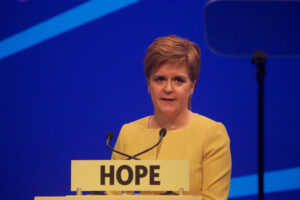
Eyebrows were raised in Brussels after the first minister launched her economic paper last Monday in which she committed to rejoining the EU without binding to the euro insisting it was not “the right option for Scotland”.
The first minister offered no timetable for re-entry but her deputy John Swinney later said he believed Scotland would become an EU country using its own currency within a decade.
The EU’s membership terms are very clear: “All EU member states, except Denmark, are required to adopt the euro and join the euro area.” Speaking to media, a senior source was equally unambiguous: “No euro, no membership.”
EU member states are understood to have become more ardently opposed to new applicants who reject the single currency since the 2016 Brexit vote.
Seven of the 13 countries that have joined the EU since 2004 have switched to the euro, most recently Lithuania on January 1, 2015. Croatia will join it next year.
Rejoining the EU is not universally popular within the SNP with some activists concerned that Scotland gains fiscal levers from London only to hand over control to Brussels. A paper on EU membership will be published as part of the Scottish government’s series of policy documents on independence.
However, there are concerns on the continent that the SNP is ignoring key details about the realities of joining the bloc, using tactics that are being compared to the Leave campaign during the Brexit referendum.
Anthony Salamone, managing director of the European Merchants, a political analysis firm based in Edinburgh, said: “Most EU figures would simply assume that, if proponents of Scottish independence were truly ‘pro-EU’, they would embrace joining the euro as well. In turn, they are surprised to discover the contrary.”
Sweden, which has taken a very slow approach to adopting the euro, may be an example the SNP wishes to follow.
Aside from currency, another factor that could delay Scotland’s entry to the EU would be its deficit, which currently stands at a notional 12 per cent.
The current target for EU members is 3 per cent with a margin of about one percentage point. That is a medium term figure which includes plans to improve the situation, meaning Scotland would not necessarily have to have reached that level before joining, but EU officials believe that the current level “does not fly” as a realistic level.
Informal calculations in the EU have suggested the best case scenario would be Scotland joining around eight years after independence.
Iceland, which was seen as a model applicant for membership because of its democratic pedigree and strong market economy, made an official bid for membership in 2009.
Iceland, which was seen as a model applicant for membership because of its democratic pedigree and strong market economy, made an official bid for membership in 2009. After completing 11 of the 35 necessary chapters to join by May 2013, it shelved talks and withdrew its application reportedly over a dispute about fishing rights in March 2015.
The Scottish government said: “An independent Scotland would benefit from re-joining the European Union and the EU will equally gain from Scotland’s membership. Scotland will continue to use sterling at the point of independence and establish a Scottish pound as soon as practicable.”
Read more:
Sturgeon told: No euro, no membership






